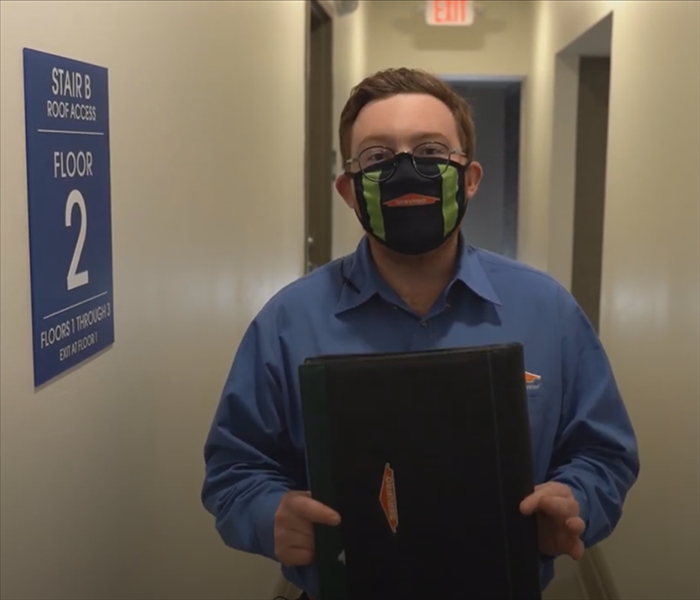VIDEO: Emergency Planning With SERVPRO
4/12/2021 (Permalink)
An effective emergency plan is the key to recovering from a disaster. But what does one look like? We put this video together to explain.
Transcript:
Many disasters can be prevented, but that doesn't mean you shouldn't plan in case something does happen.
In this section, we're going to talk about Emergency Ready Planning.
Emergency Ready Planning helps you to make a lot of decisions before anything happens so that if their disaster does occur, you're going to be ready to react quickly and intelligently and save yourself a ton of time, money and headaches.
Storing and Accessing Your Emergency Plan
First things first: you have to figure out how you're actually going to store your plan.
For most people, it makes sense to have many printed copies of their plan available throughout their property. You can put them in nice, conspicuous places like this fancy little SERVPRO padfolio.
Or, and I recommend this, you can also store them online. Digital copies, especially on the cloud, can be accessed by anyone anywhere. So if you or your facilities manager, or your wife, or your best friend, or whoever is on vacation in Aruba they're still going to be able to get the information they need to respond in case of fire, water or really any kind of disaster.
Basics of Emergency Planning
The first thing that you'll collect for your emergency ready plan is the basics. Who is the main contact? The main stakeholder at your building? Are there several? What's their contact information? What's the address? Take some pictures of the exterior as well and give first responders details on how they should access the building and where they should park.
Vital Details of Your Building
After that, it's important to collect some other details about how a first responder might have to go about their job. What year was the building built and last renovated? Who are the tenants? What's the square footage? How many floors are there? Is there a generator? Are there blueprints? Things like that, anything you would want a firefighter, police officer, paramedic or emergency responder to be aware of.
It's important to note all building access points, especially in case some are blocked by the disaster. You should also detail how that access is controlled. Is there a key, a fob, a code? Who has access to those?
You should also detail all stairwells and elevators. This is helpful for both emergency egress and for loading in any equipment that first responders might need.
Locating Your Utility Shutoffs
It's also important to note the locations of all of your utilities and their shutoffs. First, note your electricity shutoffs and breaker panel locations. These could be useful, especially if using high draw equipment in emergency response.
Knowing how to operate your sprinkler systems is a huge plus in case of emergency. On the very slight chance these systems operate accidentally, you're going to need to shut them off quickly. More likely, they're going to operate in case of emergency and knowing how to shut these off, and shut them off selectively, is very important to preventing any further water damage than what's needed to extinguish the fire.
You should also note the location and shutoffs for various alarm systems. Documenting how and where to access this not only allows you to turn these systems off and on, but it makes it easy for necessary parties to access them during and after an emergency.
You should also know where your modems, servers and any other it equipment is located in your building.
Documenting Your Chain of Command
Last, but certainly not least, you should write down all emergency contacts as well as the chain of command that you'll need to follow in case of emergency. Who's allowed to make decisions? Who should be contacted if an emergency takes place? Which vendors do you trust to call in? Documenting everything from your preferred plumber to your insurance carrier is vital. We're not going to go through everyone here, but we can send you a copy of that list.
Next Steps
We covered the basics of emergency ready planning, but it's important for you to know that every plan should be customized for what you, your employees, the janitor you hired last Tuesday, whoever needs to know in case of an emergency. Don't be afraid to get a little creative with it.
If you need a hand getting started, call SERVPRO of The Southtowns. We do these every day and we'll be happy to help you out, show you examples, whatever.
Now we're going to talk about fire prevention. If a fire actually happens, what happens next? How do the systems in your building react to keep you safe? ABJ Fire Protection is going to go into a little bit more detail about that






 24/7 Emergency Service
24/7 Emergency Service